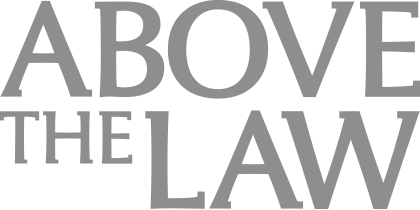Sorry About Those Billable Hours, Millennials...
Blame the Goldfarb case for all those hours that you now have to bill.
 I’ve been using the term “millennials” as has just about everyone else, for that cohort of peeps born between 1980 and 2000. Others have different definitions as to when millennial kicked in, but all are roughly in the same ballpark. In any event, the oldest millennials turn 38 this year, only several years away from protection under the Age Discrimination in Employment Act, that is, if you’re looking to switch jobs or are under-employed or unemployed.
I’ve been using the term “millennials” as has just about everyone else, for that cohort of peeps born between 1980 and 2000. Others have different definitions as to when millennial kicked in, but all are roughly in the same ballpark. In any event, the oldest millennials turn 38 this year, only several years away from protection under the Age Discrimination in Employment Act, that is, if you’re looking to switch jobs or are under-employed or unemployed.
At least our judiciary doesn’t face a mandatory retirement age, although some might think that’s a good idea. In Poland, the mandatory retirement age for judges has been reduced from 70 to 65. That’s discomfiting,
Age isn’t just a number any more, a number that you can ignore, because, whether you like it or not (and most do not), middle age doesn’t creep in on little cat feet like the Carl Sandburg poem (who’s he, you ask?). Middle age smacks you in the face (mid-life crisis time), whether it does so at 40 or 49 and can make you re-evaluate your priorities, both in life and in the law.

Law Firm Business Development Is More Than Relationship Building
I’m not going to talk about re-evaluating life priorities, that’s not my job, but re-evaluating priorities in our professional lives is something worth thinking about. What about the newbies who graduated law school after 2008 who have jobs — and aren’t just doing document review — and who are struggling to repay those student loans and still have money left over for such things as housing and food, in addition to paying the overhead on a solo or small firm practice while scrounging for clients in a fiercely competitive world that drives prices down? And if you’re in Biglaw or other firms where billables rule the roost, I don’t need to remind you about billable hour requirements
There are providers that, for a small charge, connect clients with lawyers to ask a question, and for an additional fee, additional questions. It’s the information that isn’t provided, that requires a lawyer to fish for information, that troubles me. How many times can a lawyer answer a question with just a yes or no answer? Aside from “don’t do it, because it’s illegal,” or “the risk is not worth the reward,” answers require context. We all know that one difference in facts can make all the difference in the advice. Every case turns on its facts.
As providers compete to reduce legal fees, I thought about the billable hour and how it came to be. It flourished because the minimum fee schedules that bars had used went away because of a case that said minimum fee schedules were illegal. It was a little more than 40 years ago, before many of you reading this were on the planet.
In 1975, the United States Supreme Court struck down minimum fee schedules in Goldfarb v. Virginia State Bar. Until that case, there was a minimum fee schedule (a floor, not a ceiling) that lawyers were to follow (at least in Virginia) or face discipline. Mr. and Mrs. Goldfarb couldn’t comparison shop for lawyers because the fees were the same, regardless of whom they researched to represent them in a title search of the property they wanted to buy. That did not make the Goldfarbs happy, so they sued.
Sponsored


Generative AI at Work: Boosting e-Discovery Efficiency for Corporate Legal Teams

AI Presents Both Opportunities And Risks For Lawyers. Are You Prepared?

Curbing Client And Talent Loss With Productivity Tech
Millennials, imagine a world with only landlines, no internet, no Amazon, no smartphones, not even flip phones, and you get the picture. Bleak by today’s standards, but that was what we had and we didn’t know any differently. There was little, if any, comparison shopping.
However, the law is a much more competitive business than when Goldfarb was decided. Note I use the term “business.” One of the arguments that the defendant Fairfax County Bar Association proffered in defense of minimum fee schedules was that the law was a “learned profession,” and therefore exempt from the purview of antitrust laws (e.g., it was not a “trade or commerce” within Section 1 of the Sherman Act). Chief Justice Burger, writing for the court, swatted that argument down.
The local bar also asserted that “….competition is inconsistent with the practice of a profession because enhancing profit is not the goal of professional activities; the goal is to provide services to the community.” While the bar was able to make that “straight face” argument way back when, no way today could that the same “straight face” argument could be made, given today’s environment. In fact, the Chief Justice noted that imposition of the minimum fee schedule had not been entirely altruistic, so that argument also went down the chute.
In the late 1950s, the ABA had said that lawyers were poor business people and undervalued their work. Based purely on what I’ve observed over my career, competition has eviscerated both premises. Given the ability to commoditize a lot of routine legal work and the rise of non-legal providers who undercut lawyers’ fees, undervaluing one’s services may be today more a question of ego than reality.
The irony is that had attorneys not adhered to the minimum fee schedule that the Virginia bars and other bars imposed, they could have been disciplined, but the minimum fee was price-fixing and thus a per se antitrust violation. Has the billable hour standard been the right solution? Looking at legal fees, many would say no.
Sponsored

Curbing Client And Talent Loss With Productivity Tech

Law Firm Business Development Is More Than Relationship Building
So, the Goldfarbs won and minimum fee schedules evaporated. Do we say “thank you,” or something less printable? Although this post was written in 2015, it still holds true. As associate salaries climb ever higher, the pressure to bill more billable hours increases. Billable hour rates have skyrocketed over the past few decades, way higher than what anyone probably expected as a logical outcome of Goldfarb. So, blame the Goldfarb case for all those hours that you now have to bill.
Now, has emphasis on the demands of the billable hour and its soul-sucking requirements caused re-evaluation of professional priorities? What do you think?
 Jill Switzer has been an active member of the State Bar of California for more than 40 years. She remembers practicing law in a kinder, gentler time. She’s had a diverse legal career, including stints as a deputy district attorney, a solo practice, and several senior in-house gigs. She now mediates full-time, which gives her the opportunity to see dinosaurs, millennials, and those in-between interact — it’s not always civil. You can reach her by email at [email protected].
Jill Switzer has been an active member of the State Bar of California for more than 40 years. She remembers practicing law in a kinder, gentler time. She’s had a diverse legal career, including stints as a deputy district attorney, a solo practice, and several senior in-house gigs. She now mediates full-time, which gives her the opportunity to see dinosaurs, millennials, and those in-between interact — it’s not always civil. You can reach her by email at [email protected].







